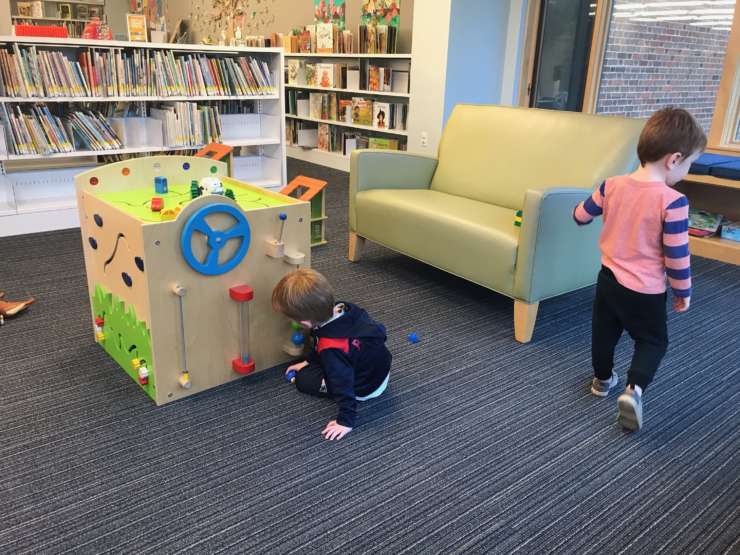What’s that noise
The first house we owned boasted a very cool feature: it had a septic tank with a special alarm that would sound any time something went wrong with the system! The alarm was shrill and insistent, demanding that we look at the high-tech control box to find out what the issue was. The first time this happened, I was home with the kids, and we all were a bit scared by the new and sudden beeping. I figured out the source, though, and called the septic company, as instructed by the high-tech control box. The septic workers responded, fixed the issue (after much tromping in muddy boots through the house to check, re-check, and then reset the control box), and all was well. Our oldest was five years old at the time, and he had hundreds of questions about the situation. What’s that sound? Who’s that guy? Why [everything that was happening]?
A few months later, lulled by the peace of a functioning septic system, we all were surprised to hear the alarm again! This time I knew what to do, and the septic company truck arrived quickly. Our five year old was prepared at the door. As soon as he saw the worker he called out, “Mom! The ‘Accept It’ guy is here!” Having misheard “septic” as “accept it,” our eldest child unwittingly had produced what remains my favorite metaphor of parenting!
Wouldn’t it be great if, every time something goes wrong in our lives, when those little alarms go off in our minds and hearts that something isn’t right, someone showed up at our door to help us Accept It? A hearty worker in muddy boots tells us, “Yeah, things are off, and I’m not sure yet how to fix it, but you’re just going to have to Accept It, my friend.” Don’t panic. Accept It.
I know there’s a lot of advice out in the world that promotes acceptance. The concept of acceptance is broad and important. Here, though, I am going to narrow it down to how acceptance actually is a CRUCIAL first step of behavior analysis and behavior change. It’s a step that we parents and humans often skip, but it’s a requirement in ABA. In our field, we call it “defining the behavior.” When we notice a behavior that we want to change because it interferes with a person’s healthy, happy life, our job is to describe it objectively and specifically. We remove emotion, judgement and bias from the definition, because those qualities cannot be observed. We never say “count the number of times the child is mean” or “observe how long he tries to make his mom mad.”
Defining the behavior neutralizes the behavior. If done correctly, it should have nothing to do with how the behavior makes another person feel, or even what other people think about the behavior. And, when we name and describe the behavior simply and exactly how it occurs, when we put aside the emotions, frustrations and concerns about the behavior, we are, in a way, Accepting It. We acknowledge and accept that the behavior occurs and likely will occur again without intervention. We Accept that the child does this behavior, and we will help the child by working to change the behavior, not the child.
As parents and caregivers (teachers, babysitters, other family members), this neutralizing, defining, Accepting step is hard. Our emotions often are tied up in our children, in their health and happiness and in what we perceive as their success (social, academic, athletic, artistic and, yes, behavioral). I’ll be the first to admit that when my twins run in opposite directions down the rows of the library, swiping books off the shelves at will, I am mainly focused on my own mortification and deep desire to get them out of there. I judge them a lot, every time. I worry that I might never have successful trips to the library or other community locations with them. For all of my kids, I spend a lot of time thinking about the things they do that I don’t “like” and the things they don’t do that I wish they would. The problem with my overthinking, worrying mode is that it rarely results in objective observation, logical analysis and effective intervention. That mode keeps me focused on my own emotions. I judge my children and fear negative outcomes for me or for them, or I fear that others might judge them negatively.
So how do we make the shift from judging and worrying about our child’s behavior to defining and Accepting mode? I’ll use my Twins at the Library example to explain the process.
- Observe the behavior. Note as much as you can about the behavior. Here are some of my notes: “We play with the library toys for about 10 minutes.

- Twin 1 leaves the toy area of the library and slowly walks to one of the book rows. I stand up to follow him. He sees me, giggles, and starts to run. He swipes at books and knocks them to the floor. I bend to pick up the books. Twin 2 watches and giggles, then runs down a different row, swiping books.”
- Determine if the behavior is a repeating pattern or isolated incident. For my twins, library running is a pattern that occurs every time I take them to the library. It does not occur when at least one of my older children is with me. It also does not occur when our babysitter brings the twins. If it were a one-time occurrence, I probably wouldn’t be telling you about it. The repeated pattern tells me it is highly likely that the twins are going to run next time we are at the library.
- Write a definition of the behavior. This can be done simply as a helpful exercise or as the next step toward data collection and intervention. But for the purpose of Acceptance, write it down. Avoid general descriptions like “Twin 1 loses it and runs away” and avoid guesses on intention “Twin 2 wants to make me mad and runs the other way.” Avoid value-laden terms like “bad behavior at the library” or even “inappropriate library behavior.” Just write what it is: “The twins move more than 2 feet away from Mommy either by walking or running. They do not return to Mommy when asked. They knock books off shelves.”
- Take a moment to Accept that this is how things are for this moment and phase in your and your child’s lives. My twins are not bad toddlers, nor am I a bad mom. They run at the library and I chase them. They knock books down and I pick them up. They probably will do those things the next time we go to the library if I keep everything the same. There, I have Accepted It.
- Decide how you will change the situation next time. This brings us into a different ABA topic, or actually into lots of ABA different topics, which I won’t discuss here. But it is important for you to see that there is a step 5. We don’t stop at Acceptance–if we stopped, we would call it Resignation instead. No, we include Acceptance because it shifts us out of judging, worrying, fretting, and all of that powerless negative emotion into logical action that will help our children move into a healthier, happier pattern of behavior.
These steps don’t take much time, and they are a nice alternative to Worried Overthinking. Parenting requires endless mental, emotional and physical effort. We can channel some of that energy into behavior analytic processes that have proven to be effective and supportive and that have positive outcomes in our parenting, too!
Of course it’s not easy, and we won’t get it right every time. Really we all could use an Accept It person to show up at our doors, to tell us things are going to be okay, just Accept where they are for now and then figure out how to make some changes. Today, let me be your Accept It person and I’ll assure you of this: your child is a wonderful person and you are a wonderful parent, and no behavior or reaction can change those objective truths. Accept It!




Comments (0)